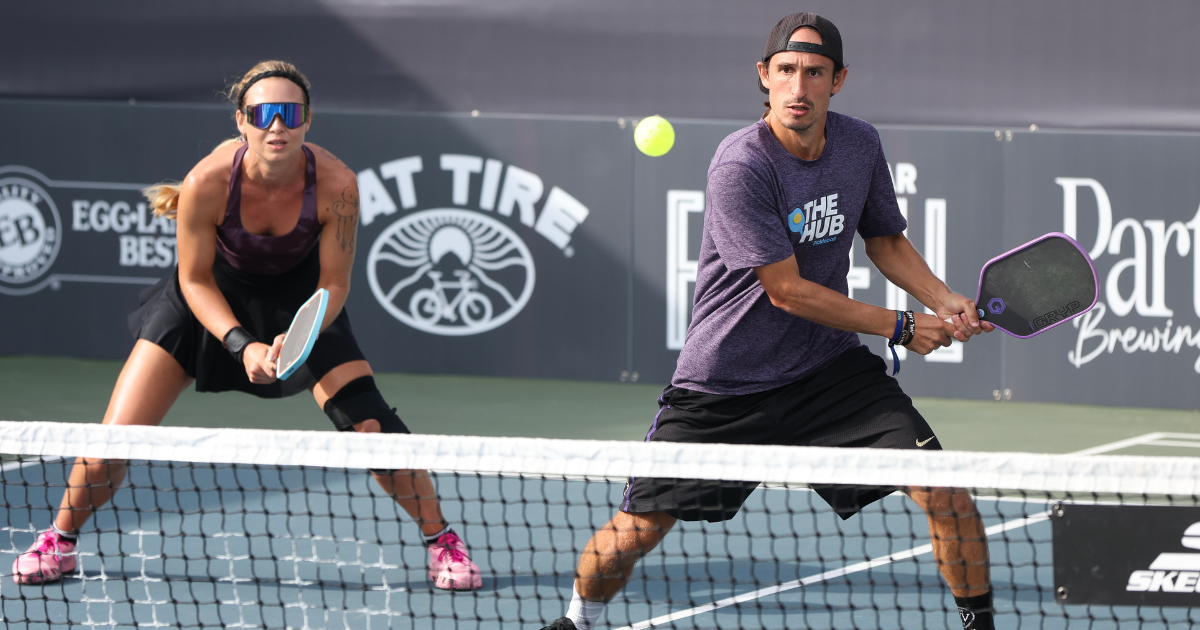Pickleball Kitchen Control: How to Win at the NVZ
In pickleball, winning doesn’t start with the smash—it starts with control. And nowhere is that control more critical than at the Non-Volley Zone (NVZ), also known as the kitchen. At the NVZ, patience, positioning, and precision are the name of the game. If you want to dominate, it’s not about overpowering your opponent—it’s about outmaneuvering them.
Smart footwork, strategic dinking, and disciplined paddle control are key. Here’s how:
Footwork: Stay Grounded, Not Lunging
The best players know that lunging is a last resort. Why? Because lunging throws you off balance, opens up the court behind you, and often leads to desperation shots. Instead, good footwork keeps you in control—and one of the most underrated movements at the kitchen line is the drop-step.
The Drop-Step: Your Safety Net for Deep Dinks
When your opponent sends a deeper dink toward your feet or pushes it toward your body, the instinct might be to lunge forward. Don’t. Instead, take a quick drop-step with your back foot to reposition.
Maintain your balance.
Avoid stepping back into the transition zone.
Give yourself space to execute a quality shot in front of your body.
By stepping back with the back foot and creating a stable base, you’re not retreating—you’re recalibrating. Once the ball is struck, immediately recover to the NVZ line and reset. This small detail ensures you get back into position and play the ball where you should—in front.
Paddle Positioning: Quiet Hands Win Battles
Control at the NVZ starts with paddle discipline. Your paddle should live in front of your body, ideally in a neutral “home” position just below chest height.
React quickly to both forehand and backhand dinks.
Transition to volleys when your opponent speeds things up.
Adjust paddle face angles without reaching or overextending.
Photo by The APP
Your hands should stay quiet and stable, especially during dinking exchanges. Flailing paddle movements or cocked wrists lead to mishits and lost points. Think minimal movement with maximum intent.
Dinking Strategy: Stretch and Reset
The NVZ isn’t a static place—it's where strategic pressure is applied. Think of your dinks like chess moves. Each one sets up the next. It’s a necessary sequence.
1. Stretch Wide First
Start by pulling your opponent wide—deep into the corners of the kitchen. Whether it's a sharply angled cross-court dink or a sideline tease, the goal is to:
Force lateral movement.
Open up space in the middle, then follow up a sideline dink with one off of their back foot to force a defensive response.
Wear down your opponent's positioning.
2. Attack the Middle with Depth
Once you’ve stretched them wide, change direction and dink to the middle—but don’t drop it short. A shallow dink invites an attack. Instead, use deep dinks to the middle to force them to cross over, ensuring they’re on defense.
The unpredictability of this sequence—wide, wide, middle, wide, middle—keeps your opponent guessing and prevents them from settling into rhythm. You’re owning the sequence and tempo of the point.
Tempo Control: Read, Respond, and Rev
The kitchen game is all about controlling the rally’s tempo. If you're dinking, you're neutral. If you're lunging, you're losing. Dink with purpose and intention, and be aggressive when the opportunity presents itself.
What do I mean by that? A nice, attractive bounce and good positioning—playing in front of your body. When the ball pops up, what do you do?
If It’s Waist-High, Do Something With It
Any ball that rises to waist level or higher is a green light to increase the tempo. Not necessarily with a full-blown drive or speed-up, but by applying pressure with intent:
Use a quick roll volley or aggressive push dink.
Hit at your opponent’s body or between partners.
Create a fast-paced exchange they didn't anticipate.
The mentality should be simple: neutral until the opportunity presents itself, then controlled aggression. This is what separates good from great. The better you get, the more important it is to take advantage of opportunities.
Control Over Chaos
At the NVZ, your greatest weapon isn’t your power—it’s poise. The players who dominate the kitchen do so with:
Balanced, responsive footwork.
Smart and stable paddle positioning.
Unpredictable, well-placed dinks.
Discipline to wait: PATIENCE.
Every movement at the NVZ should serve a purpose: to unbalance your opponent while staying balanced yourself. So the next time, remember this: don’t lunge, don’t rush, and don’t just hit—control the NVZ and your line. Own it!
Give it a try and HAVE FUN PLAYING!
About the Author: Neil Friedenberg is a certified pickleball coach and Head of Education for Empower Pickleball. He is passionate about helping players of all levels grow their skills and confidence on the court. A lifelong player with deep roots in the sport, Neil also brings experience as a paddle company owner, blending technical expertise with a love for the game.



